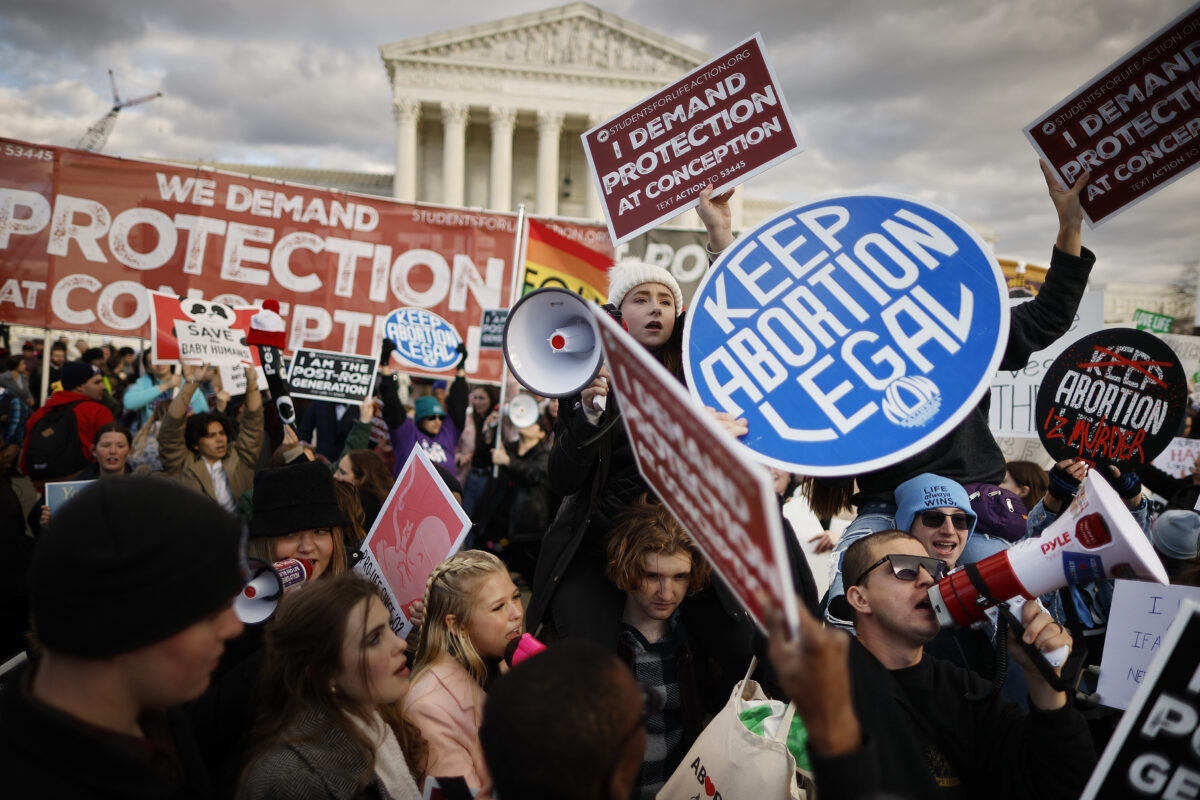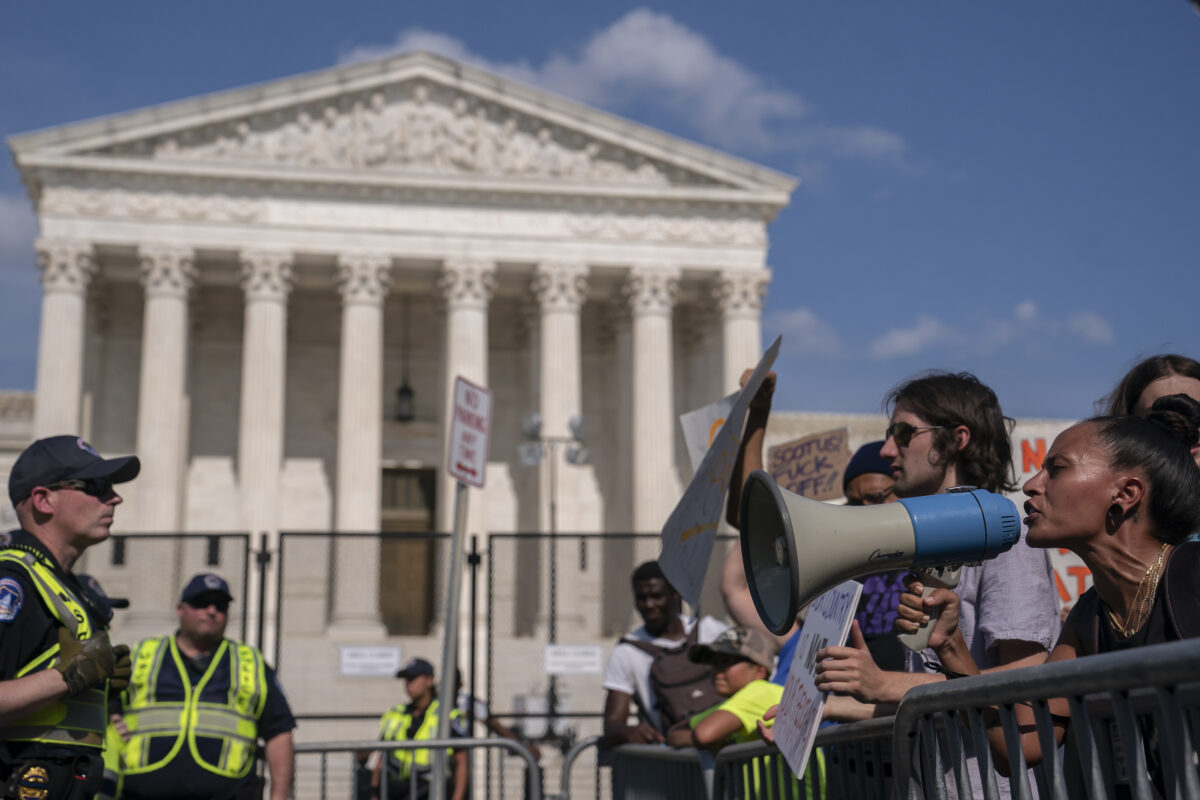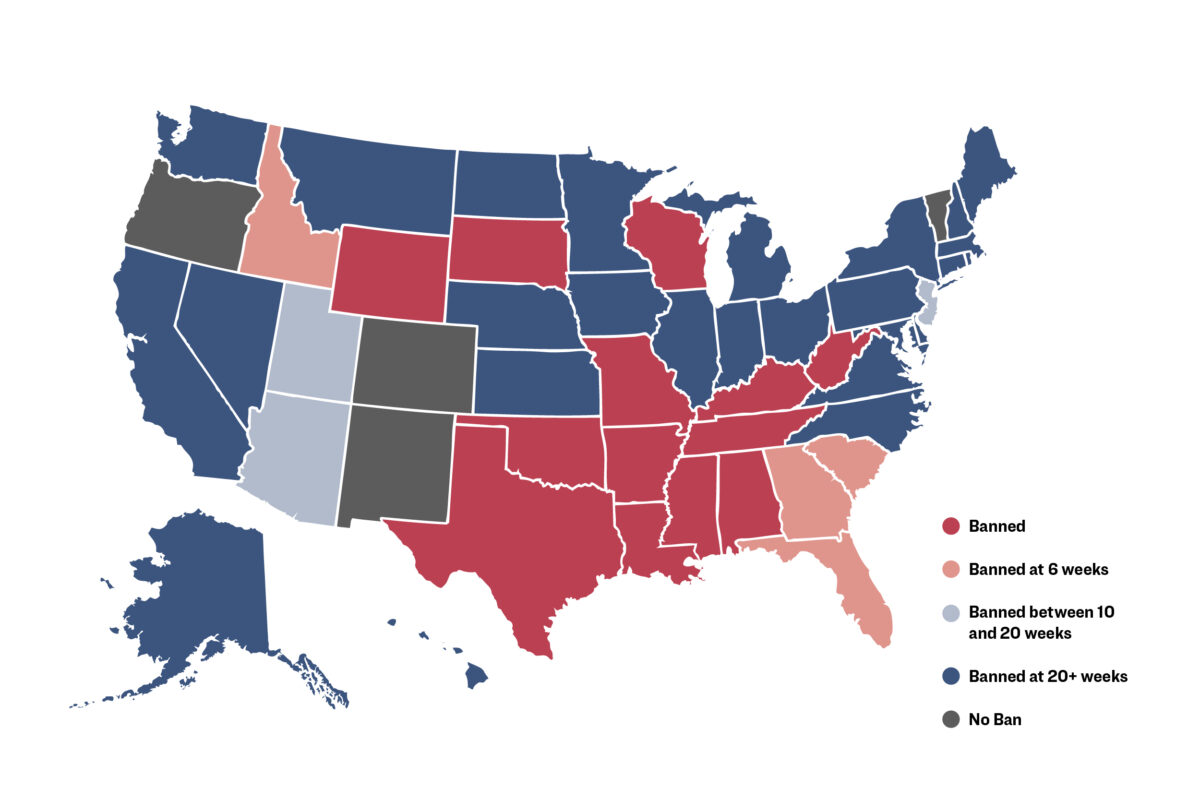Where Every State Stands on Abortion
Mark Minck’s mother was in a prime demographic in the 1960s for having an abortion—she was young, single, and pregnant.
But her choice was to place her son for adoption. And he grew up with loving parents, who made him feel proud to be adopted, and chosen, Minck told The Epoch Times.
“You were just born in your family—they had to bring you home,” he recalled thinking as a child about other children. “Well, I was adopted. I thought it was something extra-special.”
“She made the most important decision, at that moment, that she could make for my life,” Minck said. “If she made the other decision, I don’t have a life. And not only do I not have a life, if she makes a different decision, but my three children also don’t exist, and never can in the history of the world.”
They were “miraculously reunited more than 50 years later” by a “simple DNA test,” he said. It was then that he thanked her, and introduced her to her grandchildren. The reunited mother and son shared joyful holidays, love, and laughter until her passing.
Today, Minck is the state chairman of the pro-life group Protect Human Life Florida, which aims to change the state’s constitution with a Human Life Protection Amendment. It’s a mission his biological mother embraced alongside him, and one that made her “thrilled, extremely proud,” he said.
The amendment would recognize “the God-given right to life of the preborn individual,” outlawing abortion in the state.
And that effort puts Minck in a cadre of activists and legislators struggling to ban abortion state by state, nationwide.
New Political Battleground
The June 2022 Supreme Court decision to overturn Roe v. Wade created a new political battleground, giving power back to state governments to ban or protect abortion.
Back in 1973, the Supreme Court had decided in Roe v. Wade that the Constitution includes a “right to privacy” that allows women to get an abortion. At that time, the justices acknowledged three parts—or trimesters—of pregnancy.
In the first trimester, the Roe v. Wade decision allowed for no governmental abortion restrictions. The decision to terminate pregnancy was left solely to the discretion of the pregnant woman.
In the second trimester, justices ruled that states could “regulate,” but not outlaw, the procedure. In the third trimester, Roe v. Wade allowed states to restrict abortions.
Everything changed on June 24, 2022, when the Supreme Court overturned that 49-year standard in deciding a new case—Dobbs v. Jackson.
And since then, there’s been a complicated cascade of new state laws addressing abortion.
With the Roe v. Wade decision no longer guaranteeing the legality of abortions in the United States, old laws—some predating the Civil War—have become part of the debate. Some believe those old laws call for outright bans of abortion in their states.

In other states, lawmakers have passed laws restricting abortion. And then judges have blocked those new abortion bans.
And some states are strengthening legal protections for abortion.
Laws In Transition
Walter Weber, senior counsel for the American Center for Law and Justice (ACLJ), predicts the first round of victories in fights over new abortion laws likely will go to the well-funded pro-abortion lobby.
“The abortion lobby, if I’m gonna call it that, has a lot of power and a lot of money,” he told The Epoch Times. “And that often translates into electoral victories.”
Well-funded fighters can hand pro-abortion activists victories even in states where most people support pro-life measures, he said.
But as medical technology increasingly shows Americans that unborn babies are human, and as women open up about how abortion has hurt them, public opinion will swing back toward the pro-life movement, Weber predicts.
“After the dust settles on that, then I think we’re going to start seeing a rollback. But it’s going to probably take some time.”

Minck calls the resulting mix of current laws a “crazy hodgepodge.”
And as a result, pro-life leaders have been confused about what to do after the reversal of Roe v. Wade, he said.
For years, pro-life leaders proposed legislation that attempted to ban some abortions, despite Roe’s existence, or create laws that would be a “test case” for Roe, Minck said.
But with Roe overturned, these strategies no longer have a use, he said.
Pro-life leaders have been so focused on testing the waters, that they haven’t realized they can jump into the pool, Minck said.
“The focal point has been, ‘We’ve got to reverse Roe. We’ve got to reverse Roe. We’ve got to reverse Roe.’ Well, here we are.”
Since the end of Roe v. Wade, four states have banned abortions after a fetal heartbeat can be detected, generally considered to be at about six weeks’ gestation. Thirteen have banned abortion from the moment of conception, with some exceptions.
Saving the Mother’s Life
All state laws currently restricting abortion would allow the procedure if necessary to save the life of the mother.
In some cases, pregnancies, indeed, can go wrong in ways that can threaten the mother’s life.
In two out of 100 pregnancies, the fertilized egg doesn’t get all the way through the fallopian tubes to the uterus, where it should develop. This pregnancy abnormality always results in death for the baby.
An abortion can save the mother’s life.
In other rare cases, medical intervention needed to treat a condition in the mother potentially can kill her unborn child. About one in 1,000 women are diagnosed with cancer during pregnancy.
Some cancer treatments can harm unborn babies. But in most cases, women don’t need to choose between their unborn child and their life.
Four states that ban abortion from conception make an exception to allow the procedure in cases of rape or incest.
Three ban abortion after a fetal heartbeat can be detected, but only up to the 20-week point in gestation. And 26 states ban abortion after 20 weeks.
Only Oregon, Colorado, New Mexico, and New Hampshire put no time restriction on abortion.
But this number could change, as lawmakers around the country reevaluate their state’s abortion laws during their first post-Roe legislative sessions.
Many activists who protested against the overturn of Roe v. Wade said they feared legal abortion would end with the court’s decision.
Yet the majority of states—28 of the 50—continue to keep abortion legal up to halfway through pregnancy.
No Big Drop in Abortion
“Many lawmakers don’t want to touch [abortion] unless they live in safe, bright red districts where it’s popular with their base,” Minck said of the pro-life cause.
“It just gets relegated to a bullet point or a talking point in a campaign, rather than an actual ‘let’s take this on and do something about this’ issue.”
Because so many states don’t fully ban abortion, the end of Roe v. Wade barely has reduced the number of abortions in the United States. The number has only dropped by about 7 percent, according to a report by the pro-abortion Society for Family Planning.
Before the Dobbs v. Jackson decision, there were about 82,270 abortions performed in the United States every month, the report said. Now, it’s down to 77,073 abortions monthly.
If the rate stays the same, that would mean the changes triggered by Dobbs v. Jackson will move America from 987,240 abortions per year to 924,876.
There’s also evidence that women are traveling to get abortions, the report notes. States with fewer restrictions on abortion have seen overall abortion numbers increase.
Experts within the pro-life movement don’t know how accurate those figures may be, said Kristi Hamrick, vice president of media and policy for Students for Life Action.
“What we know about the number of abortions is what Corporate Abortion tells us,” she said in an email.
Either way, a long-term division between “abortion states” and “life states” won’t work well, Minck said.

“We’ve got governors of states putting up billboards saying, ‘Hey, come to our state! We’ll welcome you with open arms so you can come and kill your preborn baby,’” he said.
“And corporations are going to build [abortion] into their [human resources] benefits package.
“‘Come to New York, take in a show, see Central Park, and abort your preborn child two days before your due date!’
“How does that work long term in our country?”
With abortion’s current legal status, a woman who wants an abortion will be able to get it, said Minck.
To end abortion, pro-life activists would need to get pro-life laws or constitutional amendments on the federal level, he said.
Although it’s important for pro-life activists to fight abortion’s cultural acceptance, settling the debate in the law is the long-term solution, he said.
“I would love it if abortion was unthinkable. I would also love it if theft was unthinkable. Or drunk driving was unthinkable. Or rape, human trafficking and home invasion, or assault and child abuse. People still do that kind of stuff.”
He suspects the Supreme Court eventually will rule on whether an unborn baby is a human life.
Meanwhile, many continue to work with the aim of a nationwide ban on abortion.
Hamrick’s group is working to pass legislation on the state and national levels against the abortion pill. They also hope to pass a “national heartbeat ban,” a law prohibiting abortion after a fetal heartbeat is detectable.
“We want to see life protected as early as possible, as soon as possible, and we want to see services increase to provide support for families,” Hamrick wrote to The Epoch Times.
Her group also has petitioned the U.S. Food and Drug Association (FDA) to limit the use of the abortion pill to prevent environmental harm.
According to the complaint, waste from the abortion pill goes straight into the sewage system.
From there, the chemicals that cause abortion can harm pregnant animals or cause birth defects. Furthermore, the remains of dead babies are also flushed into the water supply from which we all drink.
“It is likely that the nation’s drinking water is contaminated in some appreciable amount by the increasing abundance of Mifepristone and human remains – as of February 2022, 54% of all abortions were performed via Mifepristone usage, up from 39% in 2017 – being flushed into the system,” the complaint reads.
Students for Life Action has asked for a temporary pause on abortion while the FDA studies the potential environmental effects of chemical abortions.
The Epoch Times contacted Planned Parenthood for comment, but the organization, the nation’s leading provider of abortions, didn’t respond.
Triggers and Blocks
Before Roe v. Wade was overturned, many states created “trigger laws” designed to snap into effect immediately if the landmark federal case were to be overturned. As long as Roe v. Wade was upheld, those measures would be considered unlawful.
But when the Supreme Court overturned Roe v. Wade, trigger laws restricting abortion quickly went into effect in 13 states.
But pro-abortion activists were ready with lawsuits.
They filed them, and, as a result, judges around the country have blocked some of those laws, at least temporarily, from restricting abortion.
In most states, judicial blocks have since ended, and those laws were allowed to go into effect.
But in other states, the blocks have proven more robust.
In Wyoming, a state constitutional amendment from 2012 says, “Each competent adult shall have the right to make his or her own health care decisions.”
Now that wording is being used to block an abortion ban passed by lawmakers.
In court, the state has argued that legislators added the wording in the hopes of counteracting potential overreach from the Patient Protection and Affordable Care Act, commonly known as Obamacare.
But Teton County District Court Judge Melissa Owens says the amendment’s wording also allows abortion in the state.

Conservative Wyoming legislators have argued that abortion isn’t health care, but the taking of a human life.
A final decision in the case hasn’t been made.
Abortion Availability
Judicial action blocking laws can have massive impacts on abortion availability.
Wyoming law under Roe v. Wade allowed abortion up to viability, the point at which a baby could survive outside the womb. Unborn babies are considered viable at 23-24 weeks of pregnancy. But babies now are surviving after being born even earlier. At least one baby has been born at 21 weeks and survived.
The new state law would ban all abortions, except in cases of rape or severe risk of death or injury to the mother. But it’s been challenged, and blocked.
Utah, Indiana, Ohio, South Carolina, North Dakota, and Iowa also have passed abortion ban laws that judges have blocked.
In Utah, Indiana, Iowa, and Ohio, there are ongoing legal battles over these judicial blocks.
In South Carolina and North Dakota, the courts struck down the states’ abortion bans.
But North Dakota has attempted to pass another law banning abortion. The ban would forbid abortion, except in the case of rape and incest before the six-week mark. This law just passed the legislature with a veto-proof majority.
Without judicial action, 23 states would have restricted abortion at six weeks’ gestation or before that.
Abortion Protections
The overturning of Roe v. Wade has caused legislators in other states to increase protections for abortion.
In the past four years, California, New York, New Jersey, Minnesota, Colorado, Michigan, Illinois, Maryland, Rhode Island, and Delaware have passed laws protecting abortion access. The laws function in varying ways.

In California, Kansas, Alaska, and Michigan, the state constitution makes abortion a right. Pro-life fighters in those states know that removing that right would be close to impossible.
All of those states require a vote by two-thirds of the legislators and a statewide referendum to amend their constitutions.
In Maryland and Rhode Island, legislators codified the federal Roe v. Wade decision into state law.
Old Laws
The overturning of Roe v. Wade also resurrected laws that had largely vanished from memory.
In Wisconsin and Arizona, laws dating back to the Civil War or earlier offered some of the strongest pro-life protections in the nation. These ancient laws ban all abortions, with exceptions only to save the mother’s life.
The Roe v. Wade decision of the Supreme Court meant those laws were no longer in effect. But state legislators never took them off the books.
Now, they’re back in force, local judges have advised.
It’s likely these legal measures wouldn’t pass in today’s Wisconsin and Arizona. Both states have divided governments, with Democratic governors and Republican-controlled legislatures.
Most Democrats favor few, if any, restrictions on abortion, while most Republicans hold pro-life views and say abortion is wrong.
These holdover laws may have a lot of past, but little future.
Before it became common knowledge that an Arizona law already on the books banned almost all abortions, Arizona lawmakers passed a law in 2022 banning abortions after 15 weeks’ gestation.
Since then, courts have ruled that Arizona’s 159-year-old law prohibiting abortion no longer applies because of the new law.

In Wisconsin, Democratic Attorney General Josh Kaul has sued to overturn an 1849 law prohibiting abortion in the state. He argues that a law passed 136 years later trumps that law. The 1985 law criminalized abortion past the point of viability.
Other old laws may have national impacts.
An 1873 federal law against the mailing of obscene or crime-inciting matter bans the mailing or receiving of “every article or thing designed, adapted, or intended for producing abortion.”
This sweeping ban could include abortion pills, surgical tools, and any other items used in abortion, Weber said. Even in states where abortion is legal, receiving by mail the tools to perform an abortion could be against the law, he said.
“If we’re right in our interpretation that the Comstock Act means what it says, and you can’t mail abortion pills, that does not mean that abortion is illegal everywhere nationally—it just means it can’t be mailed,” Weber said.
The town of Eunice, New Mexico, has sued for the enforcement of this law nationwide.
Federal enforcement of the 150-year-old law could have its greatest impact on the distribution of abortion pills, he said. Today, most abortions happen by pill, he said.
“Normally, you’re not mailing suction machines. You’re mailing the pills,” Weber said.
Abortion advocates have often described the overturning of Roe v. Wade as a “return to the past.”
But it’s likely that few imagined the past could return so powerfully to possibly put abortion at risk.
For Minck, his battle to end abortion started with his mother’s decision to “choose life,” he said. As an adult, he learned she’d never been “abortion-minded,” and made the decision to place him for adoption so he might be a blessing for a couple who couldn’t conceive.
“She would specifically tell me she was proud of me for wanting to protect the preborn, more so than ‘ending abortion,’” he said.
“It’s a subtle distinction, but it kind of ties in with our proposed [Florida constitutional] amendment that affirms life, rather than denouncing abortion.
“I think ultimately she just found it providentially amazing that her decision to choose life was having an impact over half a century later through my efforts to protect all preborn life in Florida.”
Nanette Holt contributed to this report.





